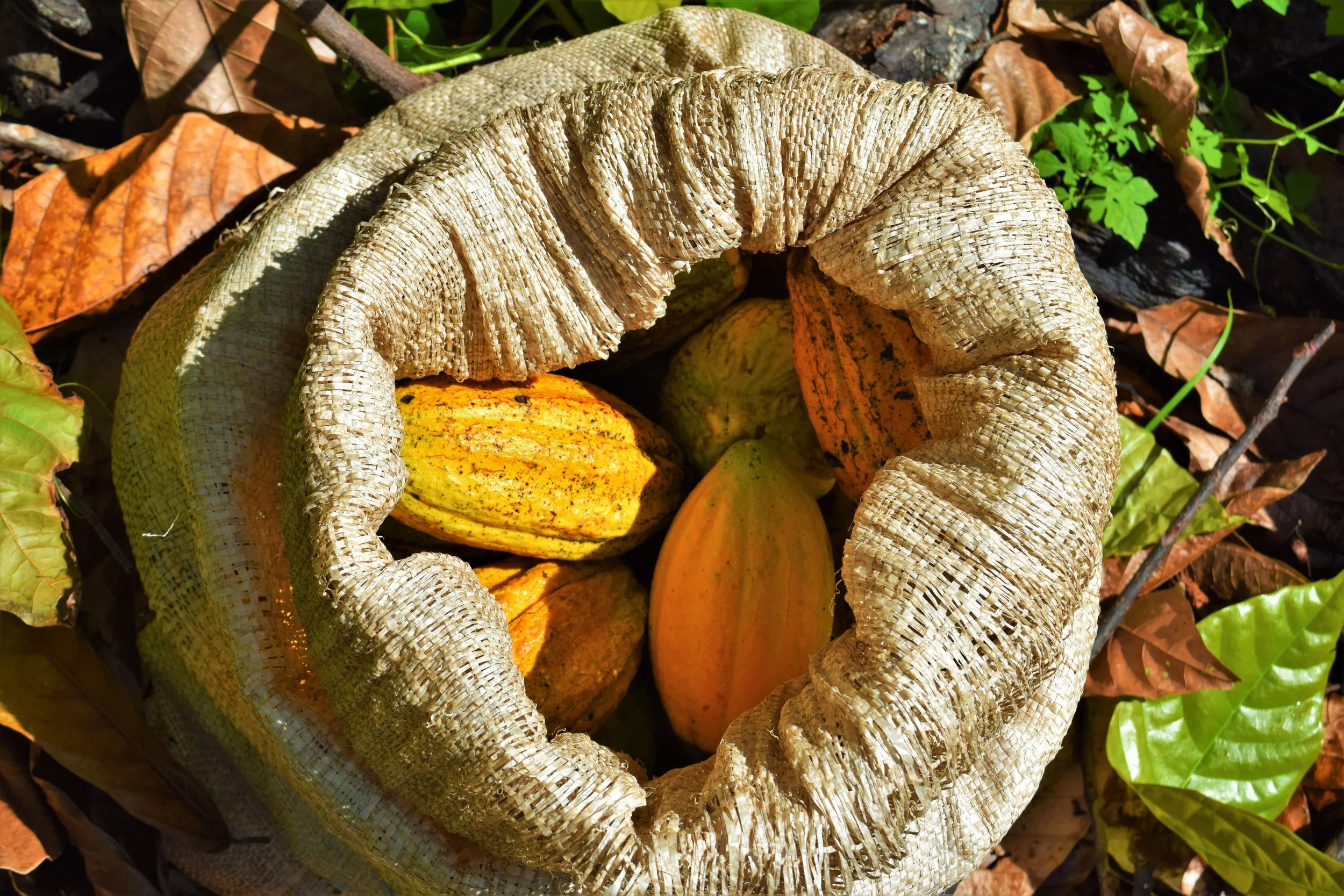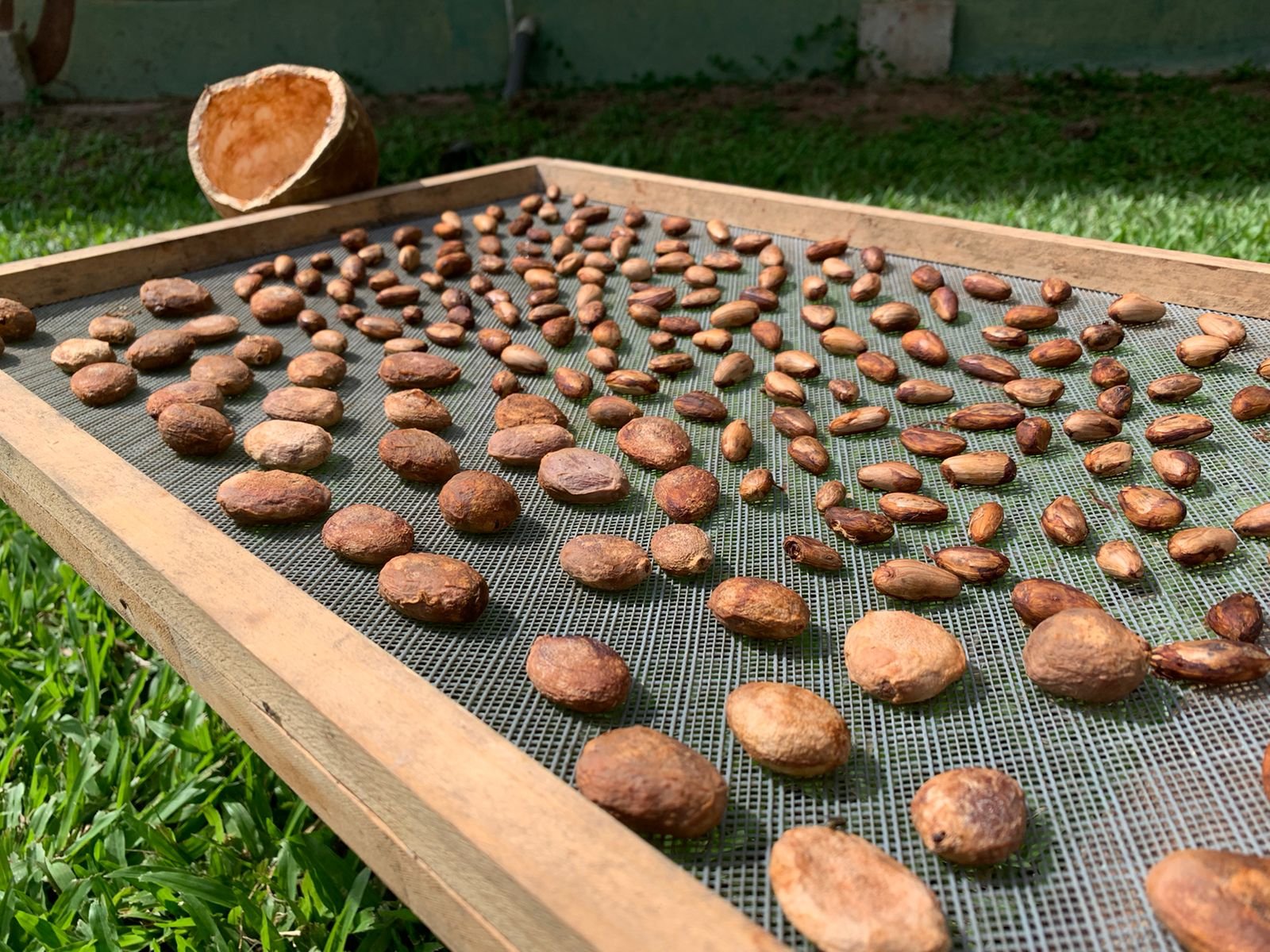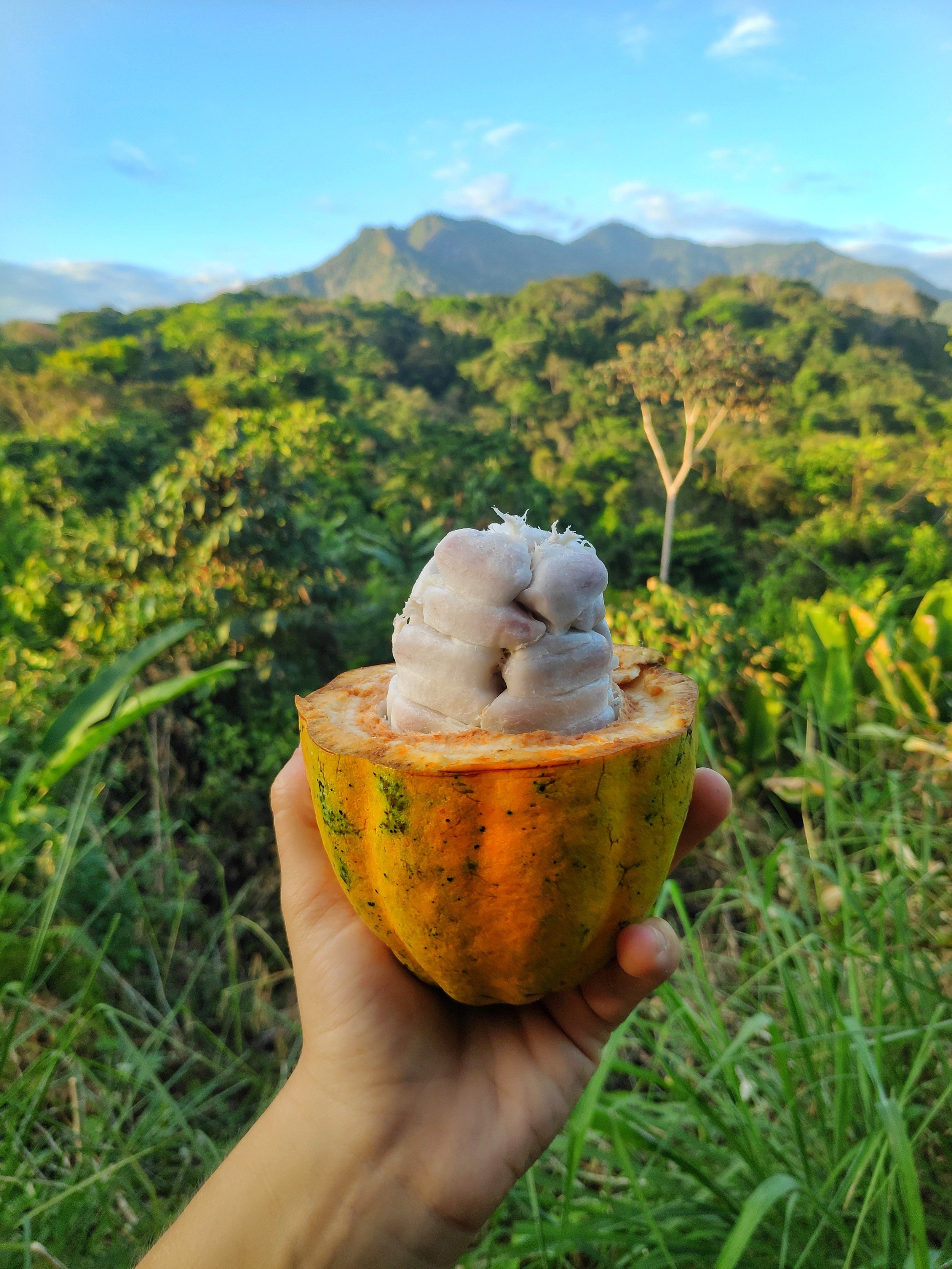Beyond Cacao: The Fruit(s) of the Gods
By 2021 Apprentice Cameron Conklin
Various forms of theobroma processing
You may have heard the term Theobroma (“theo” meaning “God” and “broma” meaning “fruit”) in reference to the genus of the cacao tree (Theobroma cacao) the incredible fruit that creates what we call chocolate. Here at the Ranch we love our cacao, but we also grow two other members of the Theobroma genus - cupuacu (Theobroma grandiflorum) and pataxte (Theobroma bicolor) who have stolen our hearts this year. Like cacao, these trees produce a fruit filled with delicious pulp and seeds and have proven to be amazing additions to our culinary experiments. These pre-Colombian species are still grown on a relatively small scale and have retained significant genetic diversity. They provide hope for a more diverse tropical forest system and chocolate industry.
A Short Description and History
The Cupuacu (Theobroma grandiflorum)
A cupuacu fruit
The cupuacu tree grows to an average height of 6-10 meters, maturing in 4 years. It has a large, brown, smooth oblong fruit (15-35 cm long), that falls to the ground when it is ready to be harvested. There are about 25 seeds per fruit protected by sweet, tangy pulp. Cupuacu is native to the Brazilian Amazon. Today it is still cultivated primarily in Brazil, but can be grown anywhere from southern Mexico to Peru. Right now, the cupuacu pulp is the most commonly used product from the fruit. The pulp is used for drinks, ice creams, pastries and other sweet treats common across Brazil. There is significantly more pulp in the cupuacu than cacao. To my surprise, the seeds are not as commonly commercialized, but there is a growing market. The seed is high in fat, about 48% (similar to 45% in cacao), which has created a budding market for industrialized cupuacu butter being used in cosmetics for skin care. Cupuacu butter has higher yields per fruit than cacao and its price is attractive for farmers. Processing accessibility seems to be the current limitation in production increase.
Yet the seed also makes for a creamy and delicious cupuacu chocolate or “cupulate” that creates light mocha-colored bars or drinks. From what I can see, there is an untapped market for an alternative chocolate product made from the cupuacu bean. The taste is tantalizing - fruity, earthy, and bright. It also has lower levels of alkaloids, theobromine, and caffeine than cacao but still retains high levels of vitamin C and anti-oxidants. The fat content makes for an extra creamy consistency. However it’s high oleic fat content is also one of its logistical downsides. It has a low melting point of 30 degrees Celsius (compared to 35 degrees for cacao) which can make transport difficult. Yet combining cacao and cupuacu together makes for a winning combination!
Here at the Ranch, we have used cupuacu for everything from making vinegars and wines, to bonbons and coconut cupuacu hot chocolate! It is truly a magical tropical fruit that I could see becoming much more popular across Central America soon.
The Pataxte
A pataxte fruit
The pataxte tree grows to an average height of 8-12 meters, maturing in 5 years. It has a large, yellow, round to oblong fruit with distinct ribs (12-30 cm long). Its pulp is tangy, and can sometimes give off the aroma of gasoline, but generally has a sweet taste. Here at the Ranch, the pataxte pulp flavor is defnintely more polarizing than cacao or cupuacu. There are about 40 seeds per fruit and the pods fall to the ground when ready to be harvested.
Similar to the history of cacao, the pataxte was developed into chocolate during the Aztec period and likely originates from the Amazon. Mesoamerican civilizations used pataxte in beverages similar to cacao. Pataxte is grown from Peru to Mexico, but today it is most commercially available in Mexico. Its seeds are used in combination with cacao to make chocolate bars or fried/roasted for savory dishes. In Oaxaca, there is a traditional beverage called the “popo” made of pataxte. Pataxte is also often used to create buttery foams on the top of traditional cacao and maize beverages in Maya culture.
Pataxte already has a history of being combined with cacao to make chocolate, but this relationship is still underutilized and certainly not pervasive in Costa Rica. Pataxte provides an incredible nutty, buttery, and sweet flavor to cacao. However, its fat content is much lower coming in at around 20%. This gives us the opposite problem of the cupuacu, making it difficult to create a creamy bar with just pataxte.
Sounds like a combination situation just might be the ticket! Here at the Ranch, we have combined pataxte with cacao and cupuacu to make bon bons, chocolate drinks and delicious chocolate sauce!
Seeing Chocolate in a New Light
A small harvest of cacao fruits
A beautiful and important lesson I’ve learned this year is that chocolate is more than just dark, hard and bitter. Experimenting with cupuasu and pataxte has showed me that chocolate can be soft, creamy, nutty, floral, and taste like red wine. Expanding my interpretation of chocolate to encompass these other Theobroma varieties has inspired me to learn more about how to grow cacao, cupuacu, and pataxte in combination. This could create a more ecologically and economically diverse and stable chocolate farm for growers across Central America. It could also create more complex and unique chocolate products for everyone to enjoy!
The Fermentation Process
These Theobromas taste best when the seeds have been fermented, letting the sugars in the pulp seep into the seeds and enhance the flavor of the beans. A typical ferment needs a fairly large number of fruits (30+) to reach the desired temperature to initiate fermentation. Due to the somewhat sporadic and limited harvest of cacao, cupuacu, and pataxte we get from our agroforestry systems, we often find ourselves needing to ferment a small number of fruits at a time (under 10). To tackle this problem, we have done everything from warming jars of seeds in hot water baths to heating them in our compost piles!
The recipe below has wound up being one of our favorite ways to “ferment” the beans. It is a two for one process creating both tasty vinegar and beans with a rich flavor profile. As sometimes happens, we actually never intended to use this recipe to ferment beans, we just decided to give the beans a try after making the vinegar. Lucky for us (and for you!) we loved the way the beans tasted after going through this process.
A mixture of Theobroma seeds that have been fermented and are drying in the sun
Recipe: Theobroma Vinegar Fermentation
Every so often, magic is created from a forgotten experiment. This recipe is just that, an experiment that was left on the back of the shelf only to be found again and turned into something delicious! This process actually produces two unique products, vinegar with notes of chocolate, red wine and nuts along with beans ready to be dried, roasted, and turned into chocolate!
When beginning with fresh pods:
Place seeds and pulp of cacao, cupuacu, and pataxte into a bucket. We have used as little as 4 fruits to as many as about 10 fruits for this process.
Fill with water, enough to cover all of the seeds and pulp sufficiently. Add more water if you would like to yield more vinegar. This is up to you!
Add 1/3 cup tapa dulce (our source of raw sugar) for every fruit in the ferment.
Leave open to oxygen but covered for bugs (we use a cheesecloth and string).
Stir once a day for 3 days.
On the third day, check the flavor of the ferment, adding more sugar if the solution has already lost significant sweetness.
Check the vinegar once a week for 3 more weeks, testing the solution to see how well the pulp has soaked off of the beans. Add more sugar if the vinegar flavor is weakening.
After about a month, check to taste - If the vinegar is tangy and the beans are relatively free of pulp (the cupuacu and pataxte will have more pulp than the cacao) then the vinegar ferment is ready.
Strain the vinegar and bottle, storing in an anaerobic environment for 6 months to age.
Wash the beans, removing any extra pulp you can, and lay out to dry in the sun.
These beans can then be used to make homemade chocolate bonbons, ground up and put in smoothies, or in the chocolate sauce recipe below.
recipe: Theobroma Chocolate Sauce
This creation is a delicacy here at the Ranch, made with three different members of the Theobroma family we grow: cacao, cupuacu, and pataxte. This sauce is a great accompaniment to almost anything sweet, but we particularly like it for drizzling over coconut macaroons (stay tuned for our upcoming recipe book). If you only have access to 1 or 2 of these beans, you can follow this same recipe and it will no doubt be delicious. The flavor profile will change as you change the ratios of the beans, so experiment as you have access to different quantities of each!
1/4 cup cacao beans
3/4 cup cupuacu beans
3/4 cup pataxte beans
1/4 cup tapa dulce
1 teaspoon vanilla extract
1/2 teaspoon sea salt
Water to taste
If beginning with fresh pods:
Ferment the beans following the “theobroma vinegar fermentation” recipe above.
Sun-dry or dry beans in a dehydrator (the skins should feel dry and no longer sticky).
Roast beans in a cast iron skillet on low for 15-20 minutes until flavors are released and shells look easy to peel.
Peel shells, separating beans out.
Grind beans all together using a heavy duty hand crank in order to release the fats, creating a paste.
On low heat, melt 1/4 cup tapa dulce (our local sugarcane), stirring in the paste. Slowly add water to create the consistency you are looking for. You can make this sauce as thick or thin as you’d like!
If you already have roasted nibs, you can skip steps 1-4 and continue with the recipe!
A cacao overlooking La Cangreja National Park
These magical and delicious fruits have some serious potential in the chocolate making market. We look forward to getting larger harvests and experimenting more with these incredible fruits.
Check out these past blogs
Farm to Table Chocolate Bonbons
Life of Spice: Farm to Table Cinnamon
How to Design, Plant, Maintain, and Feast from your Food Forest







